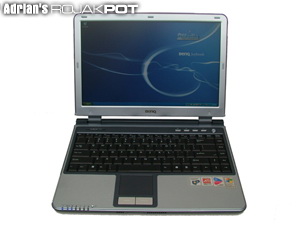The Notebook
This is how the BenQ Joybook 7000 looks like. The cool thing about the Joybook 7000 is that the chassis is made from magnesium alloy. Therefore, it is very well-built and finished. It also feels very solid, unlike many notebooks out there which use plastic chassis to cut down on cost.
Measuring 34.1 cm wide by 24.3 cm deep, the Joybook 7000 takes up just a little more desktop space than a piece of A4 paper. It's also pretty svelte at just 3.3 cm thick at the back and it tapers down to just 2.45cm thick in the front.
It's also surprisingly light at just 2.05 kg. It's impressive how BenQ managed to pack all the power and features into the Joybook 7000 while maintaining the small form factor and light weight.
Let's take a look at the different views of the BenQ Joybook 7000.
 |
 |
The front view |
The back view |
 |
 |
The left view |
The right view |
Opening the notebook reveals the 14" widescreen TFT LCD screen and the full-sized keyboard.
 |
 |
A soft protective sheet over the keyboard |
The Joybook 7000 revealed |
The wrist-rest area is fairly large, making it very comfortable to type for long periods. In addition, the keyboard is slightly slanted, making it more ergonomic. But let's leave all the details of the notebook as we explore each feature in greater detail.

Side profile of the Joybook 7000, showing the slight slant.
The Display
The BenQ Joybook 7000 comes with a 14" active-matrix TFT display. However, it is no ordinary TFT display. BenQ chose to equip the Joybook 7000 with a widescreen XGA display with a resolution of 1280 x 768. It is also one of the brightest notebook screens in the market, with a maximum brightness of 200 nits.
Check out the extra working space that the 1280 x 768 display offers over regular 1024 x 768 displays. However, I'm personally not particularly excited about this as I'm used to my desktop monitor's 1600 x 1200 resolution. After all, there are already notebooks with 1280x960 or 1400x1050 screens in the market. Even Adrian's year-old Toshiba M30 notebook came with a 1280 x 960 screen.
Frankly, both of us felt that the work space offered by the screen was rather limited. Admittedly, it's hard to do more with a 14" screen but it would have been nice if BenQ could squeeze in 1280 x 800 or 1280 x 960 for example. But if you're used to 1024 x 768 displays, then you'll definitely appreciate the extra work space offered by the Joybook 7000's wide display.
Another reason why we didn't quite like the 1280 x 768 resolution was the rather odd aspect ratio of 15:9. Remember, the widescreen DVD aspect ratio is 16:9. So, while BenQ designed the Joybook 7000 to function as a mobile DVD player, the 15:9 ratio means that you will end up with black bars at the top and bottom of the screen.
The brilliance and sharpness of this wide-screen TFT display is rather impressive though. In fact, it is one of the brightest LCD screens I've seen on notebooks. The ability to hit 200 nits really makes a difference.

Image courtesy of BenQ
BenQ named the technology responsible for the amazing brightness, DBEF™ (Display Brilliance Enhancement Film). I don't really know what this particular film does, but BenQ claims that it is a unique light-sensitive material that boosts screen brilliance by up to 33% in all lighting conditions. By comparison, standard TFT displays have a maximum brightness level of 150 nits.
However, the screen does have a rather limited viewing angle, particularly vertically. This is quite a shame since the Joybook 7000 was designed to be enjoyed from a distance with other people (thanks to its remote control). With such a restricted viewing angle, only a few can view the screen properly at one time, and they will have to bunch up pretty close.
The Hinge
Here's what BenQ has to say about their Elevated Screen Hinge Design :
"The unique axial-hinge separates and supports the screen at a height and angle that are soothing to the human eyes. This is another vivid example of human technology at work."
That's PR talk for a screen hinge that is simply just a bit longer than usual so that the screen is elevated and supports the ideal and ergonomic angle of the screen. Amazing how such simple things can be made to sound like a most exceptional feature.
 |
|
A closer look at the hinge |
Opening the display. |
To further protect the notebook, BenQ fitted the margins of the display with five rubber tabs.

A closeup look at the rubber tabs
This protects the display as well as the chassis by preventing them from touching each other when you close the lid.
<<< The Package (Continued) : Previous Page | Next Page : Keyboard, The Hotkey Panel, LED Indicators And Microphone >>>







 Add to Reddit
Add to Reddit



